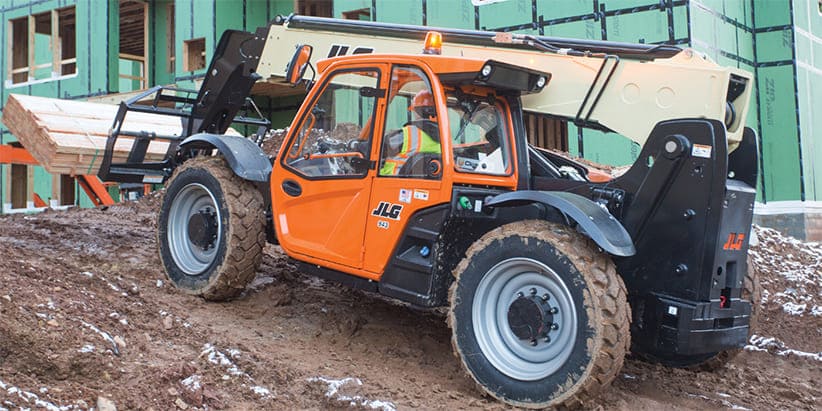 Brian Green
Brian Green
Senior Principle Engineer
____
JLG Industries
Industries like wind, oil and gas, steel erection, industrial construction, and mining present unique challenges to equipment operators. Telescopic Handlers, with a wide range of specialized attachments, can adapt to demanding job sites and replace other traditional machines.
Plus, their ability to handle heavy, bulky loads makes them ideal for performing maintenance on other machines in the rental yard. Telehandler operators have been searching for a solution that would give precise boom control when paired with a boom suspension (ride control) system.
What is a Ride Control System?
Ride Control allows operators with any level of experience to move materials easier through the linear movement of the boom. When switched on, machine movements are less jarring increasing operator confidence. It is not just comfortable maneuvering of a load in the machine that is important; it is also confidence while operating for improved productivity.
Ride control acts as a spring between the boom and the frame of the machine. It cushions the ride for the load on the forks when the machine is traversing rough terrain. It does not offer any added cushion or comfort for the operator, but it can help improve productivity by reducing damage to the load and allowing operators to quickly move over changing terrain without load stability worries.
It is not just comfortable maneuvering of a load in the machine that is important; it is also confidence while operating for improved productivity.
How Does Ride Control Work?
The Ride Control System is a boom suspension system that permits the boom, and thus the load on the fork/carriage, to absorb and dissipate energy induced by undulations in terrain when operating the telehandler while driving.
The system includes one or more accumulators, a cylinder-mounted ride control valve, a tank valve, switches to set desired operation mode, and appropriate wire harnessing. The operator input switch allows two states: Ride Control Enabled or Ride Control Disabled. When the input switch is enabled by the operator and speeds are above 3 mph the ride control system is active.

In active mode, the Ride Tank Valve and Ride Valve are energized, connecting the bore side of the lift cylinder to the accumulator (s) and the rod end of the lift cylinder to the hydraulic tank. In this manner, any change in the load due to external forces transfers via the lift cylinder to the nitrogen gas inside the accumulator (s). When Ride Control is disabled, the lift function operates as a standard machine in any operating condition; Ride Valve, Ride Tank Valve and Float Valve (if equipped) remain in the de-energized state and the Precision Gravity Lowering Components and Main Control Valve Spool fully control the lift cylinder.
Hydraulic accumulators store energy in the form of pressurized gas. The higher the pressure, the more stored energy in the gas, then the stored energy acts like a spring to absorb shock, a perfect fit for mobile equipment with very demanding high force loads. Basically, as the boom bounces, it pushes down on the oil in the hydraulic cylinders.
The oil flows to the accumulator, which has compressed nitrogen gas on the other side. Unlike oil, this nitrogen gas compresses, so it acts like a spring -- when the incompressible oil from the lift cylinder pushes down on one side of the piston, the gas compresses before pushing back up on the piston.
What are the Benefits?
The ride control option offers many advantages to machine operators. The Ride Control system compliments telehandler operation in two main ways: increased boom stability and improved transport and travel speeds. The main benefit of a ride control system on telehandlers is most visible when carrying a load. Ride control offers operators the ability to move loads while maintaining load stability through a variety of conditions.
The main benefit of a ride control system on telehandlers is most visible when carrying a load. Ride control offers operators the ability to move loads while maintaining load stability through a variety of conditions.
Improving the operator's control of a telehandler boom is key to improving the overall efficiency of telehandlers on the jobsite. Productivity significantly increases due to the benefits of improved transport, and travel speeds give operators more confidence in transporting precious loads through rough terrain. Ride Control, provides better support for the load on the forks, keeping it from being jarred or dropped, and the machine can travel faster with the load.
Telehandlers equipped with a ride control feature help save time, money, and labor on the job site by allowing operators to accomplish tasks with ease and confidence.
Telescopic Handlers offer several options to increase operator confidence and comfort on the job site. A boom suspension system, such as JLG's Ride Control, is a solution to the uneasiness associated with telehandlers when moving loads from point A to point B over challenging terrain. JLG branded telehandlers have the option of adding Ride Control to the machine to improve load stability and promote smoother operation on uneven ground giving the operator greater confidence and productivity.
Want to stay up to date with industry news and trends similar to this? Make sure you subscribe below to receive monthly updates from Direct Access with newly posted content so you never miss important information.